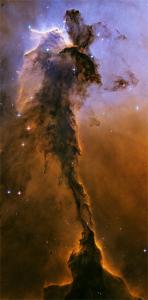 Hard to believe that it was fully fifteen years ago today that the Hubble Space Telescope was placed into orbit from the Space Shuttle Discovery. Hubble’s list of achievements has been outstanding, from detecting proto-galaxies whose light was emitted less than a billion years after the Big Bang to providing data that helped astronomers confirm the age of the universe, now calculated at some 13.7 billion years. And don’t forget the extraordinary moments closer to home, such as the space telescope’s views of comet Shoemaker-Levy 9, the famous ‘string of pearls,’ hitting Jupiter in 1994. Hubble’s 700,000 images have provided views up to ten times sharper than any previous telescope could offer.
Hard to believe that it was fully fifteen years ago today that the Hubble Space Telescope was placed into orbit from the Space Shuttle Discovery. Hubble’s list of achievements has been outstanding, from detecting proto-galaxies whose light was emitted less than a billion years after the Big Bang to providing data that helped astronomers confirm the age of the universe, now calculated at some 13.7 billion years. And don’t forget the extraordinary moments closer to home, such as the space telescope’s views of comet Shoemaker-Levy 9, the famous ‘string of pearls,’ hitting Jupiter in 1994. Hubble’s 700,000 images have provided views up to ten times sharper than any previous telescope could offer.
The image above, a part of the Eagle Nebula, shows a tower of cold gas and dust being shaped by the light of hot new stars. It was taken with Hubble’s Advanced Camera for Surveys (ACS), providing a picture so sharp that, at full resolution, the image could be blown up to the size of a billboard without losing detail.
Image: Stars in the Eagle Nebula are born in clouds of cold hydrogen gas that reside in chaotic neighbourhoods, where energy from young stars sculpts fantasy-like landscapes in the gas. The tower may be a giant incubator for those newborn stars. A torrent of ultraviolet light from a band of massive, hot, young stars [off the top of the image] is eroding the pillar. Credit: NASA, ESA, and The Hubble Heritage Team (STScI/AURA)
And ponder this: the soaring tower of gas in the photograph is roughly 9.5 light years in size, or a little more than twice the distance between the Sun and the Alpha Centauri triple star system. One thing the universe is constantly adjusting is our own sense of perspective!

